Ranger Electronic VX-129CN CB Transceiver User Manual
Ranger Electronic (Shanghai) Inc CB Transceiver Users Manual
Users Manual
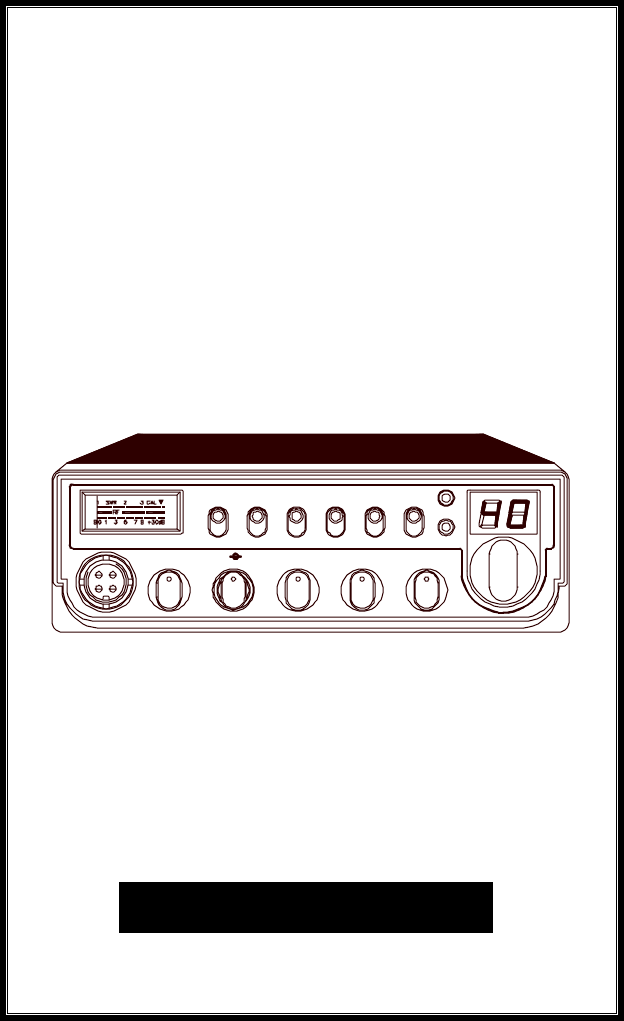
Printed In Malaysia
PD010704
ςΙΡΑΓΕ
ςΙΡΑΓΕςΙΡΑΓΕ
ςΙΡΑΓΕ
VX-129CN
SOLID STATE 40 CHANNEL
AM MOBILE CB RADIO
OWNER’S MANUAL
ς ΙΡΑΓΕ ςΞ−129ΧΝ NORMALLOWPAOFFCAL OFF
OFF
MIC GAIN VOL SQ RF GAIN SWR CAL
SWR
S/RF ANL CBNB TONE
ANT
CLARIFY
CH9
TX/RX

- 1 -
TABLE OF CONTENTS
PAGE
CHAPTER 1
Specifications . . . . . . . . . . . . . . . . . . . . . . .. . . . . . . . . . . . . . . . . . . 2
CHAPTER 2
Installation . . . . . . . . . . . . . . . . . . . . . . . . . . . . . . . . . . . . . . . . . . . 3
Location . . . . . . . . . . . . . . . . . . . . . . . . . . . . . . . . . . . . . . . . . . . . 3
Mounting The Radio . . . . . . . . . . . . . . . . . . . . . . . . . . . . . . . . . . . 3
Ignition Noise Interference . . . . . . . . . . . . . . . . . . . . . . . . . . . . . . 4
Antenna . . . . . . . . . . . . . . . . . . . . . . . . . . . . . . . . . . . . . . . . . . . . . 4
Tuning The Antenna for Optimum SWR . . . . . . . . . . . . . . . . . . . 5
External Speaker . . . . . . . . . . . . . . . . . . . . . . . . . . . . . . . . . . . . . . 6
Public Address . . . . . . . . . . . . . . . . . . . . . . . . . . . . . . . . . . . . . . . 6
CHAPTER 3
Operation . . . . . . . . . . . . . . . . . . . . . . . . . . . . . . . . . . . . . . . . . . . . 7
Front Panel . . . . . . . . . . . . . . . . . . . . . . . . . . . . . . . . . . . . . . . . . . 7
Rear Panel . . . . . . . . . . . . . . . . . . . . . . . . . . . . . . . . . . . . . . . . . . . 9
Frequency Chart . . . . . . . . . . . . . . . . . . . . . . . . . . . . . . . . . . . . . . 10
Procedure to Receive And Transmit . . . . . . . . . . . . . . . . . . . . . . . 11
Alternate Microphone And Installation . . . . . . . . . . . . . . . . . . . . 12
Maintenance And Adjustment . . . . . . . . . . . . . . . . . . . . . . . . . . . 15
A Few Rules That Should Be Obeyed . . . . . . . . . . . . . . . . . . . . . 16
How Your CB Can Serve You . . . . . . . . . . . . . . . . . . . . . . . . . . . 16
Use CH 9 For Emergency Messages Only . . . . . . . . . . . . . . . . . . 17

CHAPTER 1 SPECIFICATIONS
GENERAL
Model VX-129CN
Channels 40
Frequency Range 26.965 ~ 27.405 MHz
Emission AM
Frequency Control Phase-Lock-loop (PLL) Synthesizer
Frequency Stability 0.001%
Temperature Range -30°C to +50°C
Antenna Impedance 50 Ohms
Antenna Connectors Standard SO-239 type
Input Voltage 13.8V DC
Size 7 7/8” (W) x 9 1/4” (D) x 2 3/8” (H)
Weight 5.0 lbs.
TRANSMITTER
RF Power Output AM : 4W
Spurious Emission -55 dB
Audio Distortion 10%
Frequency Response 300 to 2500 Hz
Microphone Dynamic
RECEIVER
Sensitivity for 10 dB (S+N)/N < 1.0 uV (AM)
Squelch Sensitivity < 0.5 uV
Image Rejection More than 65 dB
AGC Figure of Merit 100 mV for 10dB Change in Audio Output
Audio Power Output 2.5W @ 10% Distortion
Audio Response 300 to 2500 Hz
(SPECIFICATIONS SUBJECT TO CHANGE WITHOUT NOTICE)
CHAPTER 2 INSTALLATION
LOCATION
Plan the location of the transceiver and microphone bracket before starting
the installation. Select a location that is convenient for operation and does not
interfere with the driver or passengers in the automobiles, the transceiver is
usually mounted the dash panel with the microphone bracket beside it.
MOUNTING THE RADIO
The transceiver is supplied with a universal mounting bracket. When
mounting the bracket and radio to your car, make sure it is mechanically
strong. Also provide a good electrical connection to the chassis of the
vehicle. Proceed as follows to mount the transceiver:
1. After you have determined the most convenient location in your vehicle,
hold the transceiver with mounting bracket in the exact location desired.
If nothing will interfere with mounting it in the desired position remove
the mounting bolts. Before drilling the holes, make sure nothing will
interfere with the installation of the mounting bolts.
2. Connect the antenna cable plug to the standard receptacle on the rear
panel. Most transceiver antennas are terminated with a type PL-259 plug
and mate with the receptacle.
3. Connect the red DC power input wire (with the fuse) to +13.8V DC.
This wire extends from the rear panel. In automobile installation, +13.8V
DC is usually obtained from the accessory contact on the ignition switch.
This prevent the set being left on accidentally when the driver leaves the
car and also permits operating the unit without the engine running.
Locate the accessory contact on most ignition switches by tracing the
power wire from the AM broadcast receiver in the car.
4. Connect the black lead to –13.8V DC. This is usually the chassis of the
car. Any convenient location with good electrical contact (remove paint)
may be used.
5. Mount the microphone bracket on the right side of the transceiver, using
two screws supplied. When mounting in an automobile, place the
bracket under the dash so that microphone is readily accessible.
- 2 - - 3 -

IGNITION NOISE INTERFERENCE
Use of a mobile receiver at low signal levels is normally limited by the
presence of electrical noise. The primary source of noise in automobile
installation is from the generator and ignition system in the vehicle. Under
most operating conditions, when signal level is adequate, the background
noise does not present a serious problem. Also, when extremely low level
signals are being received, the transceiver may be operated with vehicles
engine turned off. The unit requires very little current and therefore will not
significantly discharge the vehicle battery.
Even though the transceiver has ANL and NB controls, in some installation
ignition interference may be high enough to make good communications
impossible. The electrical noise may come from several sources. Many
possibilities exist, as variations between vehicles require different solutions
to reduce the noise.
ANTENNA
A vertically polarized, quarter-wavelength whip antenna provides the most
reliable operation and greatest range. Shorter, loaded-type whip antennas are
more attractive, compact and adequate for applications where the maximum
possible distance is not required. Also, loaded whips do not present the
problems of high wind resistant imposed by a full quarter-wavelength whip.
Mobile whip antennas utilize the metal body of the vehicle as a ground
plane. When mounted at a corner of the vehicle they are slightly directional,
in the direction of the body of the vehicle. For all practical purpose, however,
the radiation pattern is nondirectional. The slight directional characteristic
will be observed only at extreme distances. A standard antenna connector
(type SO-239) is provided on the transceiver for easy connection to a
standard PL-259 cable termination.
If the transceiver is not mounted on a metal surface, it is necessary to run a
separate ground wire from the unit to good metal electrical ground in the
vehicle. When installed in a boat, the transceiver will not operate at
maximum efficiency without a ground plate, unless the vessel has a steel
hull.
Before installing the transceiver in a boat, consult your dealer for
information regarding an adequate grounding system and prevention of
electrolysis between fittings in the hull and water.
TUNING THE ANTENNA FOR OPTIMUM S.W.R
Since there is such a wide variety of base and mobile antennas, this section
will strictly concern itself to the various types of mobile adjustable antennas.
Because the antenna length is directly related to the channel frequency, it
must be tuned to resonate optimally on all channels of the transceiver.
Channel 1 requires a longer antenna than Channel 40 because it is lower in
its frequency of operation.
Due to the various methods of adjusting antennas for proper S.W.R. we
have chosen what we think is the optimum method:
A. Antenna with adjustment screws (set screws).
1. Starts with the antenna extended and tighten the set screw lightly enough
so that the antenna can be lightly tapped with your finger for easy
adjustment.
2. Set your transceiver to Channel 20. Press the PTT (push-to-talk) switch,
and tap the antenna (making it shorter). The S.W.R meter will show a
lower reading each time the antenna is tapped. By continuing to shorten
the antenna, you will notice the S.W.R reading will reach a low point
and then start rising again. This means that you have passed the
optimum point for Channel 20.
Extend the antenna a short distance and again follow the procedure above.
When the lowest point has been reached, switch to Channel 1 and then to
Channel 40 and compare S.W.R readings. They should be almost equal.
NOTE
The proper setting is achieved when the SWR is 1.5 or
below, and when it has the same reading for channels 1
and 40.
B. Antennas which must be cut to proper length
1. Follow the same procedure as above but adjust the length by cutting in
1/8” increments until a good match is obtained.
2. Be very careful not to cut too much at one time, as once it is cut, it can
no longer be lengthed.
3. The whip is easily cut by filing a notch all the way around and breaking
the piece off with pliers.
- 4 - - 5 -
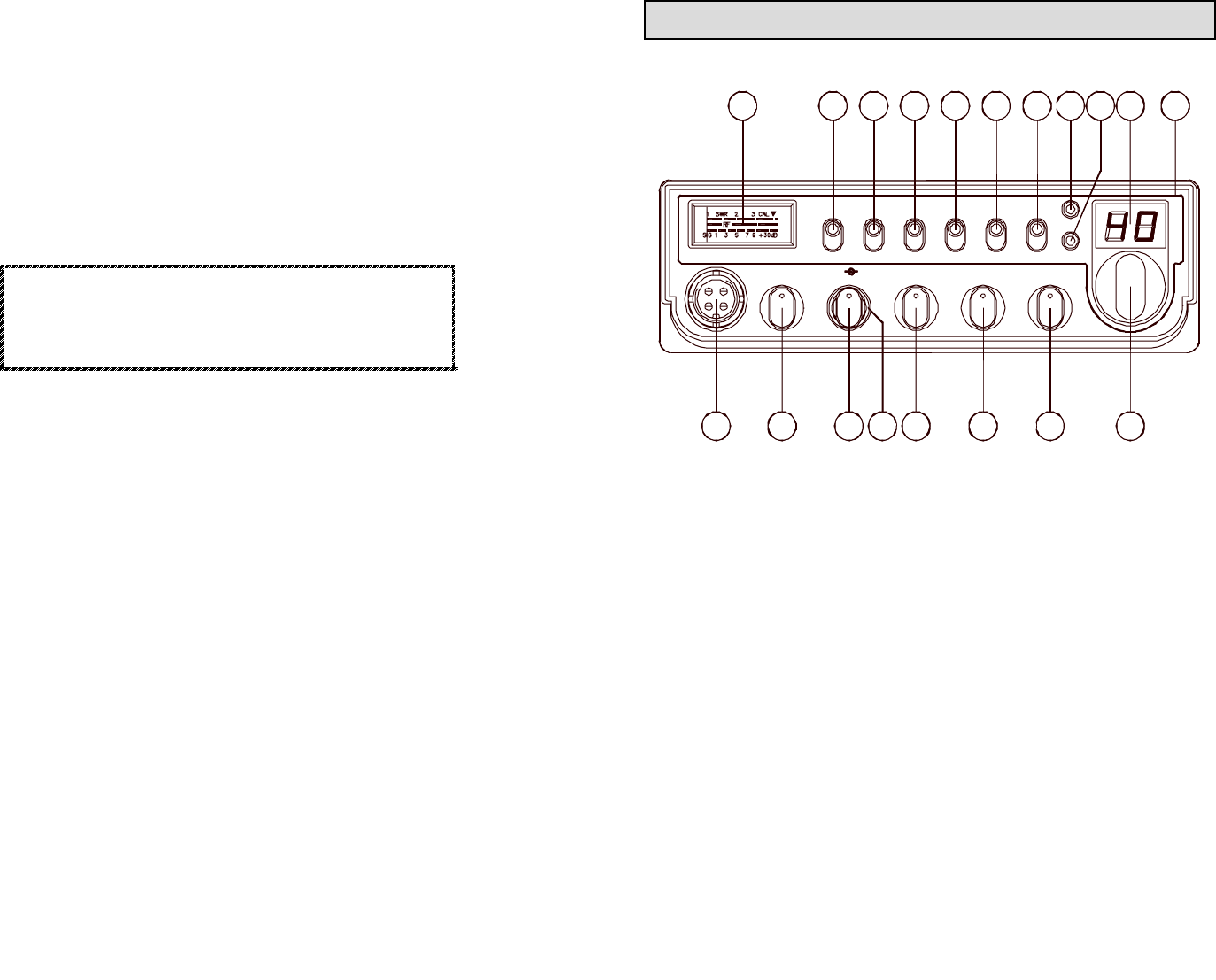
If you’re having difficulties in adjusting your antenna, check the following:
a. All doors must be closed when adjusting the antenna
b. Make sure the antenna base is grounded.
c. Check your coaxial cable routing (it may be pinched when routed into
the car)
d. Try a different location in your car (keeping in mind the radiation pattern
you wish.)
e. Is the antenna perfectly vertical?
f. Try a different location in your neighborhood. Stay away from large
metal objects when adjusting (metal telephone polls or light post, fences,
etc.)
NOTE
The transceiver will operate into an SWR of 2 to 1
indefinitely and sustain an SWR of 20 : 1 for a maximum
of 5 minutes at rated operating conditions.
EXTERNAL SPEAKER
The external speaker jack (EXT SP.) on the rear panel is used for remote
receiver monitoring. The external speaker should have 8 ohms impedance
and be able to handle at least 4 watts. When the external speaker is plugged
in, the internal speaker is disconnected.
PUBLIC ADDRESS
To use the transceiver as a public address system, connect an external 8
ohms speaker (4 watts minimum) to the PA. SP. jack located on the rear
panel. Direct speaker away from the microphone to prevent acoustic
feedback. Physical separation or isolation of the microphone and speaker is
important when operating the PA at high output levels.
CHAPTER 3 OPERATION
FRONT PANEL
1. MICROPHONE JACK : Used to connect microphone for voice source.
2. MIC GAIN CONTROL : Adjust the microphone gain in the transmit
and PA modes. This controls the gain to the extent that full talk power is
available several inches away from the microphone. In the Public
Address (PA) mode, the control function as the volume control.
3. ON/OFF VOLUME CONTROL : This knob controls the volume and
power to the radio. To turn radio on, rotate the knob clockwise. Turning
the knob further will increase the volume of the receiver.
4. SQUELCH CONTROL : This switch is used to eliminate background
noise being heard through the receiver which can be disturbing when no
transmission are being heard through the received. To use this feature,
turn the switch fully counterclockwise and then turn clockwise slowly
until the background noise is just eliminated. Further clockwise rotation
will increase the threshold level which a signal must overcome in order
to be heard. Only strong signal will be heard at a maximum clockwise
setting.
5. RF GAIN CONTROL : This control is used to reduce the gain of the
RF amplifier under strong signal conditions.
- 5 -
RF GAIN
12
MIC GAIN VOL SQ
2134
OFF
ςΙΡΑΓΕ ςΞ−129ΧΝ
SWR
CAL
S/RF
OFF
ANL
910 11
SWR CAL CLARIFY
567 8
NORMALOFF PA
NB CB
LOW
TONE
ANT
CH9
TX/RX
1513 14 1716 18 19
- 6 - - 7 -
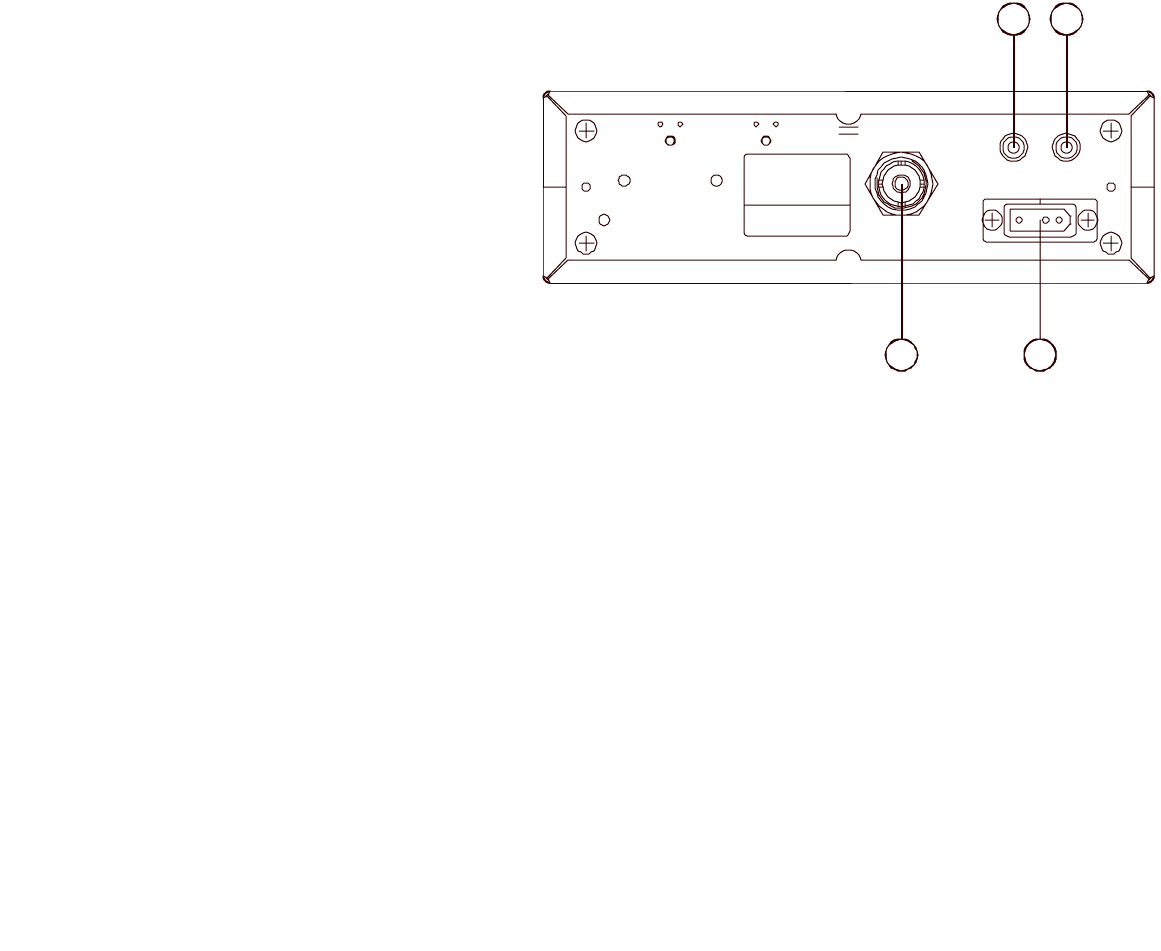
6. SWR CAL CONTROL : This SWR CAL control allows the user to
calibrate the SWR meter.
7. CLARIFY CONTROL : Allows tuning of the receive frequency above
or below the channel frequency.
8. CHANNEL SELECTOR : This control is used to select a desired
transmit and receive channel.
9. FRONT PANEL METER : The Front Panel Meter allows the user to
monitor signal strength, RF output power and SWR level.
10. S-RF/CAL/SWR SWITCH : In the S-RF position, the meter will
indicate the strength of the signal being received, as well as the relative
RF output of transmission. When calibrating the SWR meter, you need to
put this switch in the CAL position. To use the meter to measure the
standing wave ratio, turn the switch to the SWR position.
11. ANL/OFF SWITCH : In the ANL position, the Automatic Noise
Limiter (ANL) in the audio circuits is activated.
12. NB/OFF SWITCH : In the NB position, the Noise Blanker (NB) is
activated. The NB is very effective in eliminating repetitive impulse
noise such as ignition interference.
13. PA/CB SWITCH : Select the mode of operation. In the PA position, the
radio acts as public address amplifier. Your voice will come out of the
speaker that is plugged into the PA. SP. jack on the rear panel. The radio
does not operate when you are in the PA mode. In the CB position, the
PA function is disabled and the radio will transmit and receive on the
speaker that is connected.
14. TONE SWITCH HI/LO : This switch changes tone quality in receive
only. In LO position, bass is increased and in HI position, treble is
increased.
15. CH9/NORMAL SWITCH : Channel 9 switch is used for instant
selection of an emergency channel.
16. TX/RX LED : The red LED indicates the unit is in the transmit mode.
The green LED indicates the unit is in the receive mode.
17. ANT LED : This LED lights orange when your SWR is higher than
about 3:1. This is not an exact indicator of 3:1 SWR, but it is an
indication that you should check your SWR reading.
18. CHANNEL DISPLAY : The channel display indicates the current
selected channel.
19. ILLUMINATION : Face plate will illuminate when turn on the radio.
REAR PANEL
1. ANTENNA : This jack accepts 50 ohms coaxial cable with a PL-259
type plug.
2. DC POWER : This accepts 13.8V DC power cable with built-in fuse.
The power cord provided with the radio has a black and red wire. The
black goes to negative and red goes to positive.
3. PA SP. : This jack is for PA operation. Before operating, you must first
connect a PA speaker (8 ohms, 4W) to this jack.
4. EXT. SP : This jack accepts 4 to 8 ohms, 5 watts external speaker.
When the external speaker is connected to this jack, the built-in speaker
will be disabled.
- 9 -
ΜΟ∆ ΕΛ : ςΞ−129ΧΝ
τηε ΦΧΧ Ρ υλεσ.Οπερατιον ισ συβϕε χτ το
χαυσε ηαρµ φυλ ιντερφερενχε.
τηε χον διτιον τη ατ τηισ δ ε ϖιχε δ οε σ ν οτ
ΣΕ Ρ ΙΑΛ ΝΟ. :
Τηισ δεϖιχε χοµ πλιεσ ωιτη Παρτ 15 οφ
ΜΑ∆ Ε ΙΝ ΧΗΙΝΑ
Σ1Σ00001
ΦΧΧ Ι∆ :
ΜΑ∆Ε ΙΝ ΧΗΙΝΑ
+ΠΟΩ ΕΡ−
1
ΑΝΤ.
2
ΕΞΤ.ΣΠ. ΠΑ.ΣΠ.
43
- 8 -

FREQUENCY CHART
Channel Channel Frequency Channel Channel Frequency
1 26.965 MHz 21 27.215 MHz
2 26.975 MHz 22 27.225 MHz
3 26.985 MHz 23 27.255 MHz
4 27.005 MHz 24 27.235 MHz
5 27.015 MHz 25 27.245 MHz
6 27.025 MHz 26 27.265 MHz
7 27.035 MHz 27 27.275 MHz
8 27.055 MHz 28 27.285 MHz
9 27.065 MHz 29 27.295 MHz
10 27.075 MHz 30 27.305 MHz
11 27.085 MHz 31 27.315 MHz
12 27.105 MHz 32 27.325 MHz
13 27.115 MHz 33 27.335 MHz
14 27.125 MHz 34 27.345 MHz
15 27.135 MHz 35 27.355 MHz
16 27.155 MHz 36 27.365 MHz
17 27.165 MHz 37 27.375 MHz
18 27.175 MHz 38 27.385 MHz
19 27.185 MHz 39 27.395 MHz
20 27.205 MHz 40 27.405 MHz
PROCEDURE TO RECEIVE AND TRANSMIT
A. MICROPHONE
The receiver and transmitter are controlled by the push-to-talk switch on
the microphone. Press the switch and the transmitter is activated, release
switch to receive. When transmitting, hold the microphone two inches from
the mouth and speak clearly in a normal voice. This transceiver comes
complete with a low impedance dynamic microphone.
B. PROCEDURE TO RECEIVE
1. Be sure that power source, microphone and antenna are connected to the
proper connectors before going to the next step.
2. Turn VOL knob clockwise to apply power to the radio.
3. Set the VOL for a comfortable listening level.
4. Set the MODE switch to the desired mode.
5. Listen to the background noise from the speaker. Turn the SQ knob
slowly clockwise until the noise just disappears. The SQ is now properly
adjusted. The receiver will remain quiet until a signal is actually
received. Do not advance the control too far or some of weaker signals
will not be heard.
6. Set the CHANNEL selector switch to the desired channel.
7. Set the RF GAIN control fully clockwise for maximum RF gain.
8. Adjust the CLARIFY control to optimize AM signals.
C. PROCEDURE TO TRANSMIT
1. Select the desired channel of transmission
2. Set the MIC GAIN control fully clockwise.
3. If the channel is clear, depress the push-to-talk switch on the microphone
and speak in a normal voice.
- 10 - - 11 -
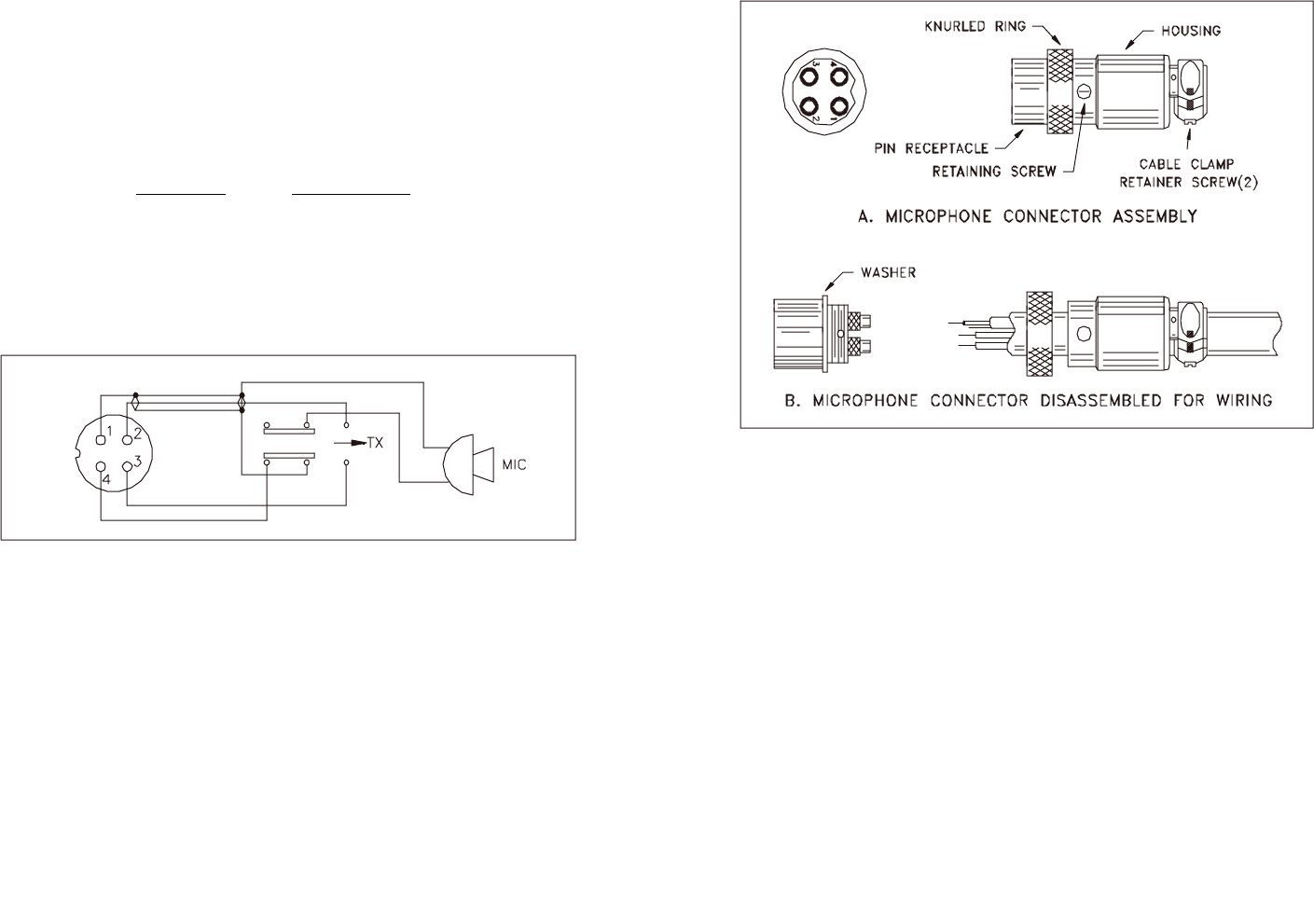
ALTERNATE MICROPHONES AND INSTALLATION
For best results, the user should select a low-impedance dynamic type
microphone or a transistorized microphone. Transistorized type microphones
have low output impedance characteristics. The microphones must be
provided with a four-lead cable. The audio conductor and its shielded lead
comprise two of the leads. The third lead is for transmit control and fourth is
for receiving control.
The microphone should provide the functions shown in schematic below.
4 WIRE MIC CABLE
Pin Number Mic Cable Lead
1 Audio Shield
2 Audio Lead
3 Transmit Control
4 Receive Control
Fig. 1 Your transceiver microphone schematic.
If the microphone to be used is provided with precut leads, they must be
revised as follows.
1. Cut leads so that they extend 7/16" beyond the plastic insulating jacket
of the microphone cable.
2. All leads should be cut to the same length. Strip the ends of each wire
1/8" and tin the exposed wire.
Before beginning the actual wiring, read carefully the circuit and wiring
information provided with the microphone you select. Use the minimum heat
required in soldering the connections. Keep the exposed wire lengths to a
minimum to avoid shorting when the microphone plug is reassembled.
Fig. 2 Microphone plug wiring
To wire the microphone cable to the plug provided, proceed as follows :
1. Remove the retaining screw.
2. Unscrew the housing from the pin receptacle body.
3. Loosen the two cable clamp retainer screws.
4. Feed the microphone cable through the housing, knurled ring and washer
as shown Figure 2.
- 12 - - 13 -
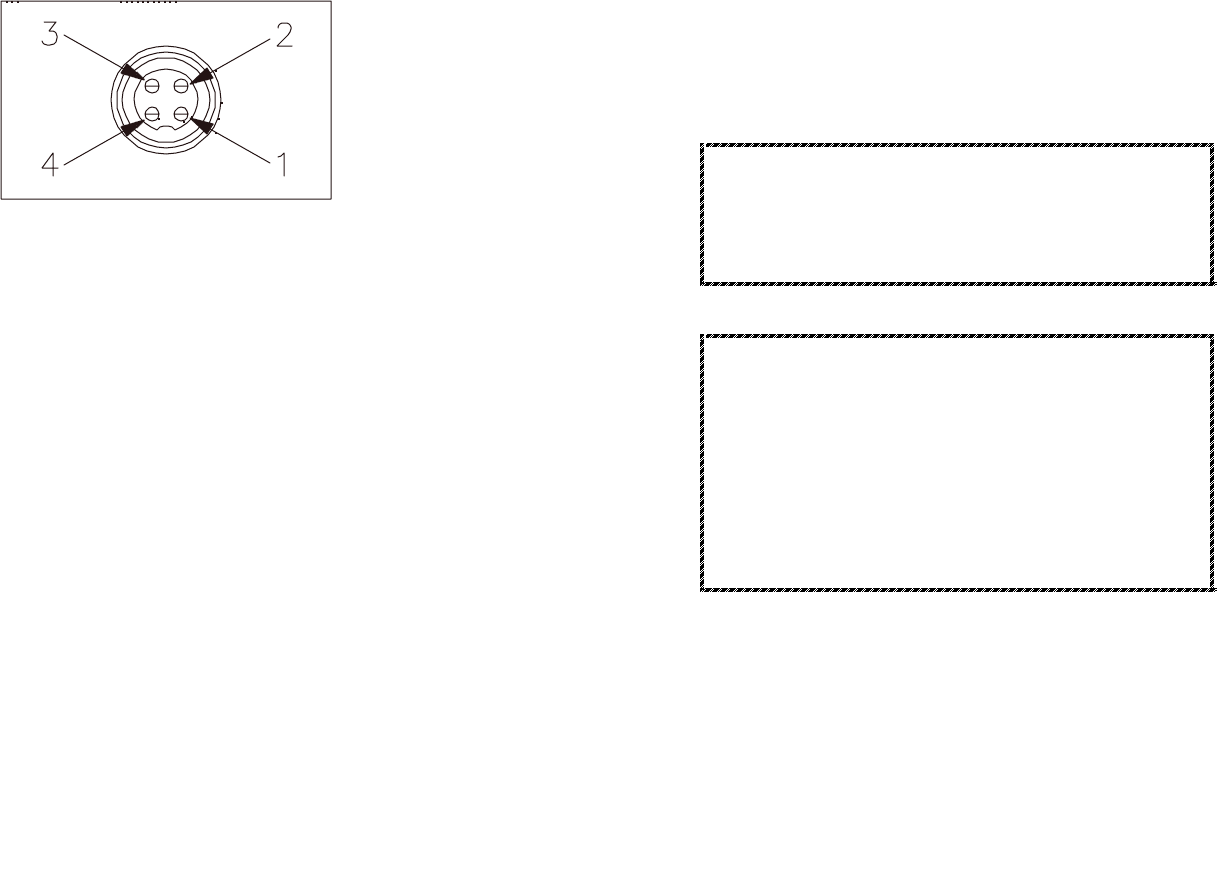
5. The wires must now be soldered to the pins as indicated in the above
wiring tables. If a vise or clamping tool is available it should be used to
hold the pin receptacle body during the soldering operation, so that both
hands are free to perform the soldering. If a vise or clamping tool is not
available, the pin receptacle body can be held in a stationary position by
inserting it into the microphone jack on the front panel. The numbers of
the microphone plug are shown in Fig. 3, as viewed from the back of the
plug. Before soldering the wire to the pins, pre-tin the wire receptacle of
each pin of the plug.
Fig. 3 Microphone plug pin numbers viewed from rear of pin receptacle.
6. Be sure that the housing and the knurled ring of Figure 2 are pushed back
onto the microphone cable before starting to solder. If the washer is not
captive to the pin receptacle body, make sure that it is placed on the
threaded portion of the pin receptacle body before soldering.
7. If the microphone jack is used to hold the pin receptacle during soldering
operation, best results are obtained when the connections to pin 1 and 3
are made first and then the connections to pins 2 and 4. Use a minimum
amount of soldering and be careful to prevent excessive solder
accumulation on pins, which could cause a short between the pin and the
microphone plug housing.
8. When all soldering connections to the pins of the microphone are
completed, push the knurled ring and the housing forward and screw the
housing onto the threaded portion of the pin receptacle body. Note the
location of the screw clearance hole in the plug housing with respect to
the threaded hole in the pin receptacle body. When the housing is
completely threaded into the pin receptacle body, a final fraction of a
turn either clockwise or counterclockwise may be required to align the
screw hole with the threaded hole in the pin receptacle body. When these
are aligned, the retaining screw is then screwed into place to secure the
housing to the pin receptacle body.
9. The two cable clamp retainer screws should now be tightened to secure
the housing to the microphone cord. If the cutting directions have been
carefully followed, the cable clamp should secure to the insulation jacket
of the microphone cable.
10. Upon completion of the microphone plug wiring, connect and secure the
microphone plug in the transceiver.
MAINTENANCE AND ADJUSTMENT
This transceiver is specifically designed for the environment encountered in
base installations. The use of all solid state circuitry and its light weight
result in high reliability. Should a failure occur, however, replace parts only
with identical parts. Do not substitute.
NOTE
If the performance described in the OPERATION and
MAINTENANCE AND ADJUSTMENT sections is not
obtained, review the operating instructions to insure that
proper procedures were followed.
FCC WARNING
This device complies with part 15 of the FCC Rules.
Operation is subject to the condition that this device
does not cause harmful interference.
All transmitter adjustments other than those provided on
front panel by the manufacturer must be made by or under
the supervision of the holder of an FCC – issued general
radio telephone operator’s license.
- 14 -

- 15 -
A FEW RULES THAT SHOULD BE OBEYED
1. You are not allowed to carry on a conversation with another station for
more than five minutes at a time without taking a one-minute break, to
give others a chance to use the channel.
2. You are not allowed to blast others off the air by over-powering them
with illegally amplified transmitter power, or illegally high antennas.
3. You can’t use the transceiver to promote illegal activities.
4. You are not allowed to use profanity.
5. You may not play music in your transceiver.
6. You may not use your transceiver to sell merchandised or professional
service.
HOW YOUR CB CAN SERVE YOU
1. Warn of traffic tie ups ahead.
2. Provide weather and road information.
3. Provide help fast in event of emergency or breakdown.
4. Suggest good spots to eat and sleep.
5. Make long trips more interesting, and help keep you awake.
6. Provide direct contact with your office or home.
7. Make friends for you as you travel.
8. Provide “local information” to find your destination.
9. Help law enforcement officers by reporting drunk and reckless drivers.
USE CH 9 FOR EMERGENCY MESSAGES ONLY
The FCC gives the following examples of permitted and prohibited types of
communications for use in an emergency. These are guidelines and are not
intended to be all inclusive.
Permitted Example Message
YES “A tornado sighted six miles north of town.
NO “This is observation post number 10. No tornado
sighted.
YES “I am out of gas on interstate 95”
NO “I am out of gas in my driveway”
YES “There is a four-car collision at exit 10 on the
Beltway, send police and ambulance.”
NO “traffic is moving smoothly on the Beltway”
YES “Base to Unit 1, the weather Bureau has just
issued a thunder storm warning. Bring the
sailboat into port.”
NO “Attention all motorists. The weather Bureau
advises that the snow tomorrow will accumulate
4 to 6 inches.
YES “There is a fire in the building on the corner of
6th and Main Streets.”
NO “This is Halloween patrol unit number 3.
Everything is quiet here.”
- 16 -

- 17 -